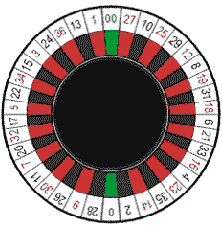 Action Player - A player who bets big and for long periods of time. Can be a euphemism for stupid player.
Action Player - A player who bets big and for long periods of time. Can be a euphemism for stupid player.
Roulette Wheel
Now we’ll take a closer look at the
roulette wheel itself. It may seem simple enough, but upon closer inspection you’ll notice the sheer intricacy of it. Weighing as much as a male bighorn sheep that weighs 300 pounds, the roulette wheel is indeed a very carefully engineered device.

There are, of course, two different types of roulette wheels: the American wheel (left) and the European wheel (right). The difference between the two wheels is that the European wheel has only one 0, while the American wheel is a bit more greedy and adds a 00 to the mix, significantly raising the house edge.
On both types of wheel, however, the numbers 1 through 36 are divided evenly among black and red above what are known as “pockets”. These are what the ball comes to rest in. These numbers are not placed on the wheel in a random fashion, however. No, no, they have been placed with order in mind my friend. A balance between red and black, high and low and odd and even numbers at any given place on the wheel was sought by the makers of the wheel. Any given even number on the wheel has the next highest even number directly across from it. The same applies to odd numbers. The colors, black and red, alternate and even number pairs alternate with odd number pairs.
The dealer at the roulette wheel is also known as a croupier (especially in France, since the word simply means dealer in French). They spin the wheel counterclockwise and release a plastic ball along a track at the top of the wheel’s cavity. When the wheel begins to slow, the ball is pulled off this track and enters the chaotic inner wheel where it bounces about before settling into a pocket. There are many small obstacles the ball will encounter in order to send it bouncing randomly before it chooses a pocket.
If you haven’t already checked out our Roulette Betting section and you’d like to learn more about the different bets that can be made on the wheel, check it out.









